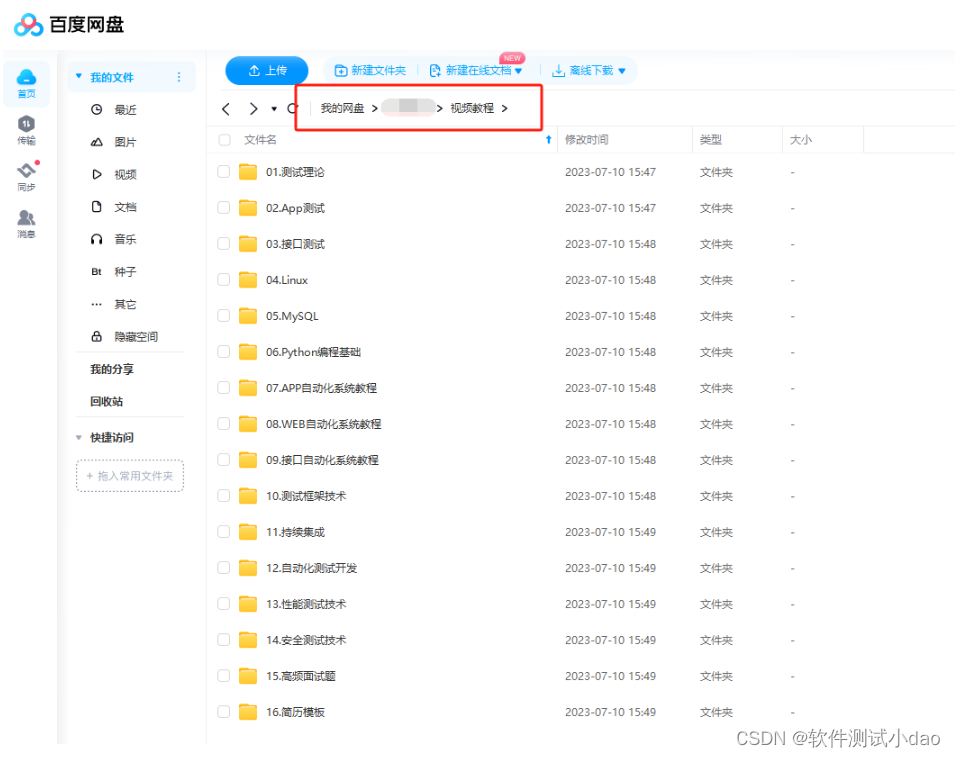背景
本文总结使用pytest编写自动化测试时常用的assert断言。
说明
本文将从以下几点做总结:
- 为测试结果作断言
- 为断言不通过的结果添加说明信息
- 为预期异常作断言
- 为失败断言自定义说明信息
为测试结果作断言
在断言方面,pytest框架比其他类似的框架(比如unittest)更加简洁,易用,我想这是我选择pytest作为自动化测试框架之一的原因之一。
pytest的assert断言关键字支持使用python内置的assert表达式。可以理解为pytest的断言就是直接使用python自带的assert关键字。
python assert的概念:
Python assert(断言)用于判断一个表达式,在表达式条件为 false 的时候触发异常。
我们可以在在assert后面添加任何符合python标准的表达式,如果表达式的值通过bool转换后等于False,则意味着断言结果为失败。
以下举例常用的表达式:
| 1 2 3 4 5 6 7 8 9 10 11 12 13 14 15 16 17 18 19 20 21 22 23 24 25 26 27 28 29 30 31 32 33 34 35 36 37 38 39 40 41 42 43 | # ./test_case/test_func.py
import pytest
from func import *
class TestFunc:
??
?def test_add_by_class(self):
??assert add(2,3) == 5
def test_add_by_func_aaa():
?assert 'a' in 'abc'
?assert 'a' not in 'bbc'
?something = True
?assert something
?something = False
?assert not something
?assert 1==1
?assert 1!=2
?assert 'a' is 'a'
?assert 'a' is not 'b'
?assert 1 < 2
?assert 2 > 1
?assert 1 <= 1
?assert 1 >= 1
?assert add(3,3) == 6
'''
# 以上全是合法的表达式且表达式的值都为True,所以测试结果为通过
============================= test session starts =============================
platform win32 -- Python 3.7.0, pytest-5.3.4, py-1.8.1, pluggy-0.13.1 -- D:\Python3.7\python.exe
cachedir: .pytest_cache
rootdir: D:\Python3.7\project\pytest, inifile: pytest.ini
plugins: allure-pytest-2.8.9, rerunfailures-8.0
collecting ... collected 2 items
test_case/test_func.py::TestFunc::test_add_by_class PASSED?????????????? [ 50%]
test_case/test_func.py::test_add_by_func_aaa PASSED????????????????????? [100%]
============================== 2 passed in 0.06s ==============================
[Finished in 1.8s]
'''
|
为断言不通过的结果添加说明信息
在编写测试时,为了提高易用性,我们想知道断言失败时的一些关于失败的原因等说明信息,assert也能满足该功能。
请看示例:
| 1 2 3 4 5 6 7 8 9 10 11 12 13 14 15 16 17 18 19 20 21 22 23 24 25 26 27 28 29 30 31 32 33 34 35 36 37 38 | # ./test_case/test_func.py
import pytest
from func import *
class TestFunc:
?def test_add_by_class(self):
??assert add(2,3) == 5
def test_add_by_func_aaa():
?assert add(3,3) == 5, "3+3应该等于6"
'''
============================= test session starts =============================
platform win32 -- Python 3.7.0, pytest-5.3.4, py-1.8.1, pluggy-0.13.1 -- D:\Python3.7\python.exe
cachedir: .pytest_cache
rootdir: D:\Python3.7\project\pytest, inifile: pytest.ini
plugins: allure-pytest-2.8.9, rerunfailures-8.0
collecting ... collected 2 items
test_case/test_func.py::TestFunc::test_add_by_class PASSED?????????????? [ 50%]
test_case/test_func.py::test_add_by_func_aaa FAILED????????????????????? [100%]
================================== FAILURES ===================================
____________________________ test_add_by_func_aaa _____________________________
????def test_add_by_func_aaa():
?????
>??? assert add(3,3) == 5, "3+3应该等于6"
E??? AssertionError: 3+3应该等于6
E??? assert 6 == 5
E????? -6
E????? +5
test_case\test_func.py:14: AssertionError
========================= 1 failed, 1 passed in 0.09s =========================
[Finished in 1.4s]
'''
|
为预期异常作断言
在某些测试用例中,比如异常测试用例,测试的结果必然是失败并应该爆出异常的。这时候自动化测试用例的期望结果就是该异常。如果期望结果等于该异常,那么测试用例执行通过,否则用例结果为失败。pytest提供为为预期异常作断言的方法:pytest.raises()。一般结合with上下文管理器使用。
使用示例:
| 1 2 3 4 5 6 7 8 9 10 11 12 13 14 15 16 17 18 19 20 21 22 23 24 25 26 27 28 29 30 31 32 33 34 35 36 37 38 39 40 41 42 43 44 | # ./func.py
def add(a,b):
?if isinstance(a,int) and isinstance(b,int):
??return a+b
?else:
??raise NameError('数据类型错误')
# ./test_case/test_func.py
import pytest
from func import *
class TestFunc:
?# 正常测试用例
?def test_add_by_class(self):
??assert add(2,3) == 5
# 异常测试用例,期望结果为爆出TypeError异常
def test_add_by_func_aaa():
?with pytest.raises(TypeError):
??add('3',4)
???
# ./run_test.py
import pytest
if __name__ == '__main__':
?pytest.main(['-v'])
'''
============================= test session starts =============================
platform win32 -- Python 3.7.0, pytest-5.3.4, py-1.8.1, pluggy-0.13.1 -- D:\Python3.7\python.exe
cachedir: .pytest_cache
rootdir: D:\Python3.7\project\pytest, inifile: pytest.ini
plugins: allure-pytest-2.8.9, rerunfailures-8.0
collecting ... collected 2 items
test_case/test_func.py::TestFunc::test_add_by_class PASSED?????????????? [ 50%]
test_case/test_func.py::test_add_by_func_aaa PASSED????????????????????? [100%]
============================== 2 passed in 0.06s ==============================
[Finished in 1.4s]
'''
|
接下来看看没有爆出预期异常的示例:
| 1 2 3 4 5 6 7 8 9 10 11 12 13 14 15 16 17 18 19 20 21 22 23 24 25 26 27 28 29 30 31 32 33 34 35 36 37 38 39 40 41 42 43 44 45 46 47 48 49 50 51 52 53 54 55 56 57 58 59 60 61 62 | # ./func.py
def add(a,b):
?# 指定异常
?raise NameError("天降异常")
?if isinstance(a,int) and isinstance(b,int):
??return a+b
?else:
??raise NameError('数据类型错误')
# ./test_case/test_func.py
import pytest
from func import *
'''
class TestFunc:
?# 正常测试用例
?def test_add_by_class(self):
??assert add(2,3) == 5
'''
# 异常测试用例,期望结果为爆出TypeError异常
def test_add_by_func_aaa():
?with pytest.raises(TypeError):
??add('3',4)
???
# ./run_test.py
import pytest
if __name__ == '__main__':
?pytest.main(['-v'])
'''
============================= test session starts =============================
platform win32 -- Python 3.7.0, pytest-5.3.4, py-1.8.1, pluggy-0.13.1 -- D:\Python3.7\python.exe
cachedir: .pytest_cache
rootdir: D:\Python3.7\project\pytest, inifile: pytest.ini
plugins: allure-pytest-2.8.9, rerunfailures-8.0
collecting ... collected 1 item
test_case/test_func.py::test_add_by_func_aaa FAILED????????????????????? [100%]
================================== FAILURES ===================================
____________________________ test_add_by_func_aaa _____________________________
????def test_add_by_func_aaa():
?????with pytest.raises(TypeError):
>???? add('3',4)
test_case\test_func.py:14:
_ _ _ _ _ _ _ _ _ _ _ _ _ _ _ _ _ _ _ _ _ _ _ _ _ _ _ _ _ _ _ _ _ _ _ _ _ _ _ _
a = '3', b = 4
????def add(a,b):
?????# 指定异常
>??? raise NameError("天降异常")
E??? NameError: 天降异常
func.py:4: NameError
============================== 1 failed in 0.09s ==============================
[Finished in 1.4s]
'''
|
判定用例执行结果为失败。
上面我们只是断言了异常的类型。但有的时候我们想更进一步断言异常的说明信息,pytest也可以做到。with pytest.raises()执行结束后会生成一个ExceptionInfo的实例对象。该对象包含type , value, traceback属性。value属性就是我们需要的异常说明信息。
见示例:
| 1 2 3 4 5 6 7 8 9 10 11 12 13 14 15 16 17 18 19 20 21 22 23 24 25 26 27 28 29 30 31 32 33 34 35 36 37 38 39 40 41 42 43 44 45 46 47 48 49 50 51 52 53 54 55 56 57 58 59 60 61 62 63 64 65 66 67 | # ./func.py
def add(a,b):
?if isinstance(a,int) and isinstance(b,int):
??return a+b
?else:
??raise TypeError('数据类型错误')
??
# ./test_case/test_func.py
import pytest
from func import *
class TestFunc:
?# 正常测试用例
?def test_add_by_class(self):
??assert add(2,3) == 5
# 异常测试用例,期望结果为爆出TypeError异常
def test_add_by_func_aaa():
?with pytest.raises(TypeError) as E:
??add('3',4)
?print(E.type)
?print(E.value)
?print(E.traceback)
?# 加入该不通过断言为了查看stdout
?assert 1 == 2
# ./run_test.py
import pytest
if __name__ == '__main__':
?pytest.main(['-v'])
'''
============================= test session starts =============================
platform win32 -- Python 3.7.0, pytest-5.3.4, py-1.8.1, pluggy-0.13.1 -- D:\Python3.7\python.exe
cachedir: .pytest_cache
rootdir: D:\Python3.7\project\pytest, inifile: pytest.ini
plugins: allure-pytest-2.8.9, rerunfailures-8.0
collecting ... collected 2 items
test_case/test_func.py::TestFunc::test_add_by_class PASSED?????????????? [ 50%]
test_case/test_func.py::test_add_by_func_aaa FAILED????????????????????? [100%]
================================== FAILURES ===================================
____________________________ test_add_by_func_aaa _____________________________
????def test_add_by_func_aaa():
?????with pytest.raises(TypeError) as E:
??????add('3',4)
?????print(E.type)
?????print(E.value)
?????print(E.traceback)
>??? assert 1 == 2
E??? assert 1 == 2
E????? -1
E????? +2
test_case\test_func.py:18: AssertionError
---------------------------- Captured stdout call -----------------------------
<class 'TypeError'>
数据类型错误
[<TracebackEntry D:\Python3.7\project\pytest\test_case\test_func.py:14>, <TracebackEntry D:\Python3.7\project\pytest\func.py:6>]
========================= 1 failed, 1 passed in 0.10s =========================
[Finished in 1.4s]
'''
|
控制台输出的“Captured stdout call”就是异常的信息,包含类型,异常说明,异常跟踪信息。
可以通过assert断言这些信息。
也可以通过给pytest.raises()传入match关键字参数来完成E.value的断言,这里运用到的是python中正则表达式的原理。
示例:
该示例意味断言通过
| 1 2 3 | def test_add_by_func_aaa():
?with pytest.raises(TypeError, match=r'.*类型错误$') as E:
??add('3',4)
|
该示例意味断言失败:
| 1 2 3 4 5 6 7 8 9 10 11 12 13 14 | # 异常测试用例,期望结果为爆出TypeError异常
def test_add_by_func_aaa():
?with pytest.raises(TypeError, match=r'.*正确$') as E:
??add('3',4)
'''
During handling of the above exception, another exception occurred:
????def test_add_by_func_aaa():
?????with pytest.raises(TypeError, match=r'.*正确$') as E:
>???? add('3',4)
E???? AssertionError: Pattern '.*正确$' not found in '数据类型错误'
test_case\test_func.py:14: AssertionError
'''
|
如果,某个测试用例可能出现不同的预期异常,只要爆出的异常在预期的几个异常之内,那么如何断言呢。解决方法很简单,原理和接口都没变,只是在pytest.raises()中传入异常类型的参数,从传入一个异常类型,改变为传入一个异常类型组成的元组。同样只是传入一个参数。
示例:
| 1 2 3 4 5 6 7 8 9 10 11 12 13 14 15 16 17 18 19 20 21 22 23 24 25 26 27 28 29 30 31 32 33 34 35 36 37 38 39 40 41 42 43 44 45 | # ./func.py
def add(a,b):
?raise NameError('名字错了')
?if isinstance(a,int) and isinstance(b,int):
??return a+b
?else:
??raise TypeError('数据类型错误')
??
# ./test_case/test_func.py
import pytest
from func import *
'''
class TestFunc:
?# 正常测试用例
?def test_add_by_class(self):
??assert add(2,3) == 5
'''
# 异常测试用例,期望结果为爆出TypeError异常
def test_add_by_func_aaa():
?with pytest.raises((TypeError,NameError),match=r'.*错.*$') as E:
??add('3',4)
??
??
# ./run_test.py
import pytest
if __name__ == '__main__':
?pytest.main(['-v'])
??
'''
============================= test session starts =============================
platform win32 -- Python 3.7.0, pytest-5.3.4, py-1.8.1, pluggy-0.13.1 -- D:\Python3.7\python.exe
cachedir: .pytest_cache
rootdir: D:\Python3.7\project\pytest, inifile: pytest.ini
plugins: allure-pytest-2.8.9, rerunfailures-8.0
collecting ... collected 1 item
test_case/test_func.py::test_add_by_func_aaa PASSED????????????????????? [100%]
============================== 1 passed in 0.04s ==============================
[Finished in 1.4s]
'''
|
为失败断言自定义说明信息
这种行为,相当于改变了pytest的运行方式,虽然只是一种锦上添花的改变。我们通过编写hook函数来改变pytest的行为。hook函数是pytest提供的,有很多,各个hook函数的详细定义应该参考pytest的官方文档。
为失败断言自定义说明信息是通过pytest_assertrepr_compare这个hook函数完成的。
先看没有编写pytest_assertrepr_compare这个hook函数时,默认的失败断言说明:
| 1 2 3 4 5 6 7 8 9 10 11 12 13 14 15 | def test_add_by_func_aaa():
?assert 'aaa' == 'bbb'
'''
================================== FAILURES ===================================
____________________________ test_add_by_func_aaa _____________________________
????def test_add_by_func_aaa():
>??? assert 'aaa' == 'bbb'
E??? AssertionError: assert 'aaa' == 'bbb'
E????? - aaa
E????? + bbb
test_case\test_func.py:16: AssertionError
'''
|
再看编写pytest_assertrepr_compare这个hook函数后:
| 1 2 3 4 5 6 7 8 9 10 11 12 13 14 15 16 17 18 19 20 21 22 23 24 25 26 27 28 | # ./conftest.py
def pytest_assertrepr_compare(op, left, right):
????if isinstance(left, str) and isinstance(right, str) and op == "==":
????????return ['两个字符串比较:',
????????????????'?? 值: %s != %s' % (left, right)]
# ./test_case/test_func.py
import pytest
def test_add_by_func_aaa():
?assert 'aaa' == 'bbb'
'''
.F?????????????????????????????????????????????????????????????????????? [100%]
================================== FAILURES ===================================
____________________________ test_add_by_func_aaa _____________________________
????def test_add_by_func_aaa():
>??? assert 'aaa' == 'bbb'
E??? assert 两个字符串比较:
E???????? 值: aaa != bbb
test_case\test_func.py:15: AssertionError
1 failed, 1 passed in 0.09s
[Finished in 1.5s]
'''
|
pytest还提供其他的hook函数,这些函数的作用就是用来改变pytest的运行方式和运行效果。所以编写第三方插件一般是使用这些hook函数。
?现在我也找了很多测试的朋友,做了一个分享技术的交流群,共享了很多我们收集的技术文档和视频教程。
如果你不想再体验自学时找不到资源,没人解答问题,坚持几天便放弃的感受
可以加入我们一起交流。而且还有很多在自动化,性能,安全,测试开发等等方面有一定建树的技术大牛
分享他们的经验,还会分享很多直播讲座和技术沙龙
可以免费学习!划重点!开源的!!!
qq群号:485187702【暗号:csdn11】
最后感谢每一个认真阅读我文章的人,看着粉丝一路的上涨和关注,礼尚往来总是要有的,虽然不是什么很值钱的东西,如果你用得到的话可以直接拿走!?希望能帮助到你!【100%无套路免费领取】



